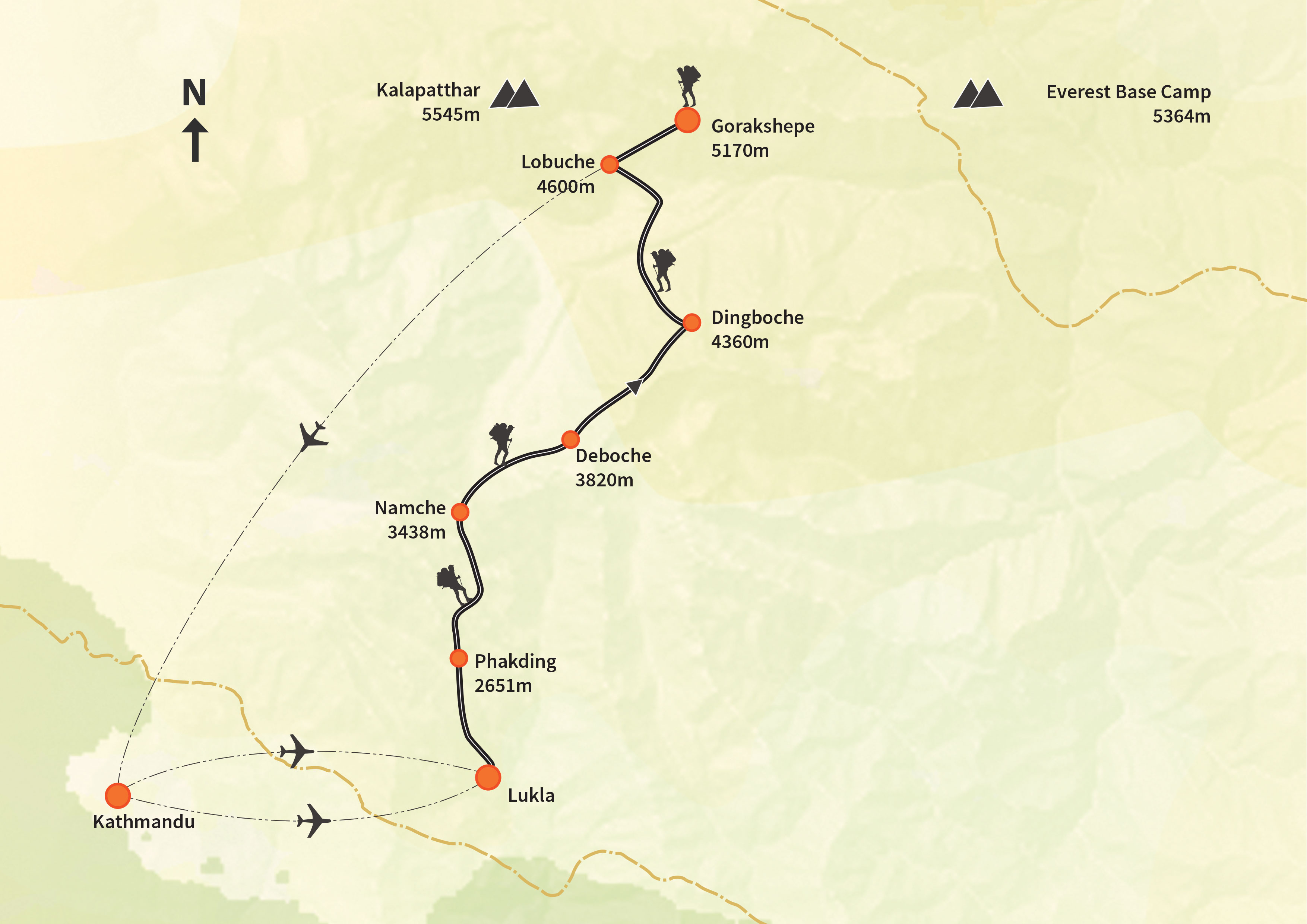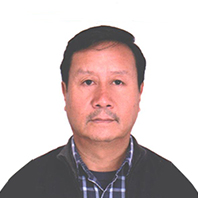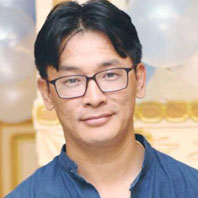
Everest Comfort Lodge Heli Trek
The Everest Base Camp Trek is one of the most famous treks in the world. This Everest Base Camp Heli trek takes you through the Sherpa land following the footsteps of Hillary to Everest Base Camp. You fly back from Lobuche in Helicopter enjoying the spectacular view of the Himalayas arriving straight to Lukla in 15 minutes from where you take regular flight to Kathmandu.
Trip Highlights
- Enjoy your stay in our comfortable luxury lodges throughout the trek. More info: yetimountainhome.com.
- Visit Everest Base Camp and Kalapatthar along with the Sherpa cultures and the Sherpa land.
- Experience flying back on an exciting Heli ride to reach Kathmandu the same day from Gorakshepe.
Detailed Itinerary
Day 1: Arrival in Kathmandu
Depending on your arrival time, our representative will be at the airport to receive you and transfer you to your booked hotel. Evening time can be spent taking a tour in busy Thamel Street or just enjoying your beer in the hotel garden.Meals: B
Hotel: Gokarna Forest Resort
Day 2: Free Day in Kathmandu
Your free day in Kathmandu today can be used relaxing in the hotel or taking an optional day sightseeing to the cultural heritage sites in Kathmandu.Meals: B
Hotel: Gokarna Forest Resort
Day 3: Fly to Lukla (2860m) and Trek to Phakding (2651m) – 3 Hrs Walk
The first flight to Lukla takes place very early in the morning. Depending on the time, you will have your breakfast either in the hotel or upon arrival in Lukla. You will be transferred to the domestic terminal of Kathmandu Airport from where you take your flight to Lukla which is about 40 minutes landing on the narrow, sleeping runway high above the Dudh Koshi River. Your porters and support staff will be waiting at the airport to help you with your luggage to start your trek to Phakding.The trek to Phakding is easy walk for the first day with mostly downhill leg. The trek will take you through pastoral lands through several small villages and farms. Approximately after 3 hours we reach Phakding where we spend our overnight in the tea houses that are probably run by Sherpas.
Meals: BLD
Hotel: YMH Phakding
Day 4: Trek to Namche (3438m) – 4/5 Hrs Trek
An easy walk today through Monjo will take us through the pine trees and glimpses of distant snowcapped peaks. We will encounter few impressive waterfalls and yaks along the way taking necessary foods and other essentials for the trekkers as well as the locals. We will pass through the checkpoint before reaching Monjo where the officials check our permits. All trekkers to this region require National Park Entry Fee. Our guide will sort out the paper works while you can stroll around for a bit. After this you officially enter the Sagarmatha National Park and a little way up the trail, you will arrive in Monjo where you will stop for lunch.After Lunch, you start your trek through the wooded valley on a good trail crossing the river through high suspension bridge. Right after the bridge is the upward climb towards Namche. An hour and half long ascent to Namche is famous among the locals as “Namche Ko Ukalo” meaning the uphill of Namche. It’s all uphill till you reach Namche, and about an hour before reaching Namche your hard work will be rewarded by your first view of Everest. Your guide will walk you to the lodge you will be staying overnight.
Meals: BLD
Hotel: YMH Namche
Day 5: Acclimatization Day in Namche
Situated at high altitude, Namche Bazaar serves as an acclimatization stop for climbers to avoid altitude sickness. Namche Bazaar is the main center of the Khumbu region and is facilitates with government offices, internet, ATM’s, restaurants and a colorful market. You can also take a half day excursion to the internationally known Museum of Sherpa Culture and the traditional villages of Khunde and Khumjung. The location of our lodge is superb giving us a bird’s eye view over Namche and across the Valley to the serrated ridges of the Kongde range, while the magnificent peak of Thamserku (6623m) rises as a backdrop. Just a short walk away is a classic view of Ama Dablam, one of the most beautiful mountains in all Nepal and of Lhotse and Everest. This is an ideal place to spend the day, acclimatizing to the new altitude before heading further up-valley to Thame.Meals: BLD
Hotel: YMH Namche
Day 6: Trek to Deboche (3820m) – 6/7 Hrs Trek
Today we will ascend towards the biggest monastery of the Everest region located at Tengboche. It encloses within Sagarmatha National Park which is listed in a UNESCO world heritage site. The trek to Phunki will be easy, but soon the ascending will start becoming challenging. The panoramic view of the Himalayas from the monastery shows us a divine universe built under the same range. We can observe a Buddhist religious ceremony. A descend for about 20 minutes from Tengboche brings us to Deboche we spend our overnight.Meals: BLD
Hotel: YMH Thame
Day 7: Trek to Dingboche (4360m) – 5/6 Hrs Trek
With a magnificent view of a rhododendron forest followed by a bridge over the raging Imja Khola (River), we ascend towards Dingboche. We’ll pass the valley wall and then the plain to Pangboche village, the biggest settlement of the Sherpa in the region. This can be a great opportunity to have a lunch with the Sherpa locals and talk about their life in the Himalayas.Overnight in Lodge
Meals: BLD
Day 8: Acclimatisation in Dingboche
Before advancing forward, today we’ll rest our legs and settle our body with the increasing altitude. Optional trek to the valley will pay off with rewarding views, but taking it easy for today is the important thing. Although, we can climb a ridge located behind the village and see six of the world’s tallest peaks including Lhotse, Makalu and Cho Oyu.Overnight in Lodge
Meals: BLD
Day 9: Trek to Lobuche (4600m) – 5/6 Hrs
From here on forth, trek will become more challenging due to the high altitude. By trekking steep to the top of a high hill, we will pass Dughla (Thukla). Before reaching Dughla, we trek across a wide pass which is much needed change from walking in a straight line. The company of Himalayas will be on all sides on our trek. After crossing Dughla, the trail passes through boulder-strewn slopes. As the trail drops to the Khumbu Glacier moraine, we find ourselves facing great peaks.Overnight in Lodge
Day 10: Trek to Gorakshepe (5170m). Visit Everest Base Camp (5364m) and Back. – 4 Hrs Trek
For further advancement, we take the trail through the once vast Gorakshepe Lake. We pass through rocky dunes, moraine, and streams. You head out on narrow tracks which are of few feet wide and few hundred meters above the ground. The distance between Lobuche and Gorakshepe is of 4.5km and will take approximately 2 hours to reach.From Gorakshepe, It is approximately 3.4km to the Base Camp. As you walk across the rocks towards the many prayer flags that mark the spot, you will arrive at Everest Base Camp. During the expedition season, many of the groups are settled here in their respective camps awaiting their climb to the highest mountain in the world. You can even interact with some of them. It will take approximately 2.5 hours to reach Everest Base Camp from Gorakshepe.
After taking photographs and enjoying the moment, we head back towards Gorakshepe for the overnight.
Overnight in Lodge
Meals: BLD
Day 11: Visit Kalapatthar (5545m) and Back to Lobuche – 5 Hrs Trek – Fly Back to Kathmandu
Kalapatthar altitude is often given as 5550m but the hill, further along, is a little bit higher. One fact is that you do not see the top of Kalapatthar from Gorakshepe, only a false summit which is much lower. It is a fairly tiring walk up there unless you are well acclimatized. The views from the summit are memorable. Everest views are the best you can get from this place. Descent from Kalapatthar is easy, just a quick straight down walk to. We have our breakfast here and trek down to Lobuche from where we fly back to Lukla in helicopter arriving in Lukla in 15 minutes where we stop to take a regular flight back to Kathmandu.Meals: B
Hotel: Gokarna Forest Resort
Day 12: Free Day in Kathmandu
You can spend your free day in Kathmandu relaxing at the garden of the hotel sipping chilled beer or enjoying the spa or just swimming in the heated swimming pool of the hotel.Meals: B
Hotel: Gokarna Forest Resort
Day 13: International Departure
Depending upon your flight time, you will be transferred from Hotel to airport. The airport time is 3 hours prior to departure time and the hotel checkout time is 12:00PM. In case you are flying late evening and require a half day use of the hotel, you can let us know in order to confirm the room for you.Essential Info
Visa
Most nationalities require a visa for Nepal, which can be obtained in advance or on entry. If you wish to apply before departure the current visa cost is £20 for a 15 day visa and £35 for a 30 day visa for UK passport holders. The current cost of a visa on arrival is US $25 for 15 days, US $40 for 30 days or if extending your stay $100 for 90 days. All are multiple entry. The visa on arrival fee can be paid for in cash in US Dollars, Pounds Sterling or Euros. You will also need a passport photo. Application forms are available in the immigration hall (or for electronic passports there are visa registration machines which, after inserting your passport, automatically fill out a form for you). You must firstly join the queue to pay the visa fee, and then go to the relevant immigration desk to obtain your 15, 30 or 90 day visa stamp. There can be long queues for visas on arrival.Non UK nationals should check requirements with their nearest embassy (a few nationalities are not permitted visas on arrival).
Vaccinations
There are no mandatory vaccination requirements. Recommended vaccinations are: Polio, Tetanus, Diphtheria, Typhoid, Hepatitis A. The risk of malaria is present in certain regions only (such as Chitwan); you may wish to consult your GP or travel health clinic for further advice. Dengue fever is a known risk in places visited. It is a tropical viral disease spread by daytime biting mosquitoes. There is currently no vaccine or prophylaxis available for Dengue, and therefore the best form of prevention is to avoid being bitten. We recommend you take the usual precautions to avoid mosquito bites. Most of our trips to Nepal go to high altitudes where there is a risk of being affected by Acute Mountain Sickness. Our itineraries are designed to enable everyone to acclimatise to these altitudes, but you should be aware that it is still possible for you to be affected. Please refer to the TRIP NOTES for complete advice on AMS.Eating & Drinking
Breakfast is included throughout the trip and all meals are provided while camping (all breakfasts, 3 lunches and 2 dinners).Breakfast is included throughout the trip and all meals are provided while camping. On trek the breakfast will be a set menu usually consisting of porridge and toast. Any additional items that are not included in the set menu should be ordered and paid for separately. We do not include lunch and dinner in the tea-houses, allowing you to choose what you want to eat and when. Although most lodges have almost identical menus, they are reasonably extensive and offer a varied selection, ranging from traditional Nepalese dal bhat to pizza and apple pie.
Although meat is available in the tea houses, we advise against eating it on trek. The meat has often been carried in the heat from lower altitudes for several days before reaching the lodges, and can cause stomach upsets or illness. Germs can also be spread by handling dirty money - we recommend using hand sanitiser.
If you buy imported food and drink whilst on trek you will spend more than the suggested amount.
Drinking Water
Staying hydrated is important when undertaking any physical activity but particularly so at altitude where it is generally recommended to drink at least 3-4 litres per person per day.
We strongly encourage you not to buy bottled water on trek as this contributes to the growing problem of plastic pollution in Nepal’s trekking areas.
All tea houses will provide cold water free of charge, if requested. Although this should not be drunk untreated, we recommend that you bring a reusable bottle with a wide opening (Nalgene or similar) with you and use a SteriPEN to treat it with. A SteriPEN is a handheld UV water purifier – small, lightweight and battery powered so easy to pack for a trek. In Nepal’s trekking regions most of the bottled water isn’t strictly ‘mineral water’ anyway but is UV treated, so it’s exactly the same technology. It’s quick to use, far more effective than purification tablets, and the water is ready immediately. It’s fine to use a SteriPEN on non-boiled water so long as it isn’t cloudy or full of sediment (which is uncommon in these regions).
SteriPENs are widely stocked on Amazon, outdoor shops and other online retailers; look for the latest models but avoid USB charging ones. Better still, a SteriPEN will pay for itself over the course of the trek and you won’t leave behind a single plastic bottle – you will end up spending the same or even less than you would on bottled water, plus you can keep it for future trips.
If you prefer not to invest in a SteriPEN, the tea houses also sell boiled water for approx. Rs150-300 per litre (the price increases the higher you trek) which should not require treating. This is also perfect for a bedtime refill as it can double up as a hot water bottle.
While camping boiled water is supplied for drinking.
Weather
The main trekking season in Nepal is from October to mid-May when daytime temperatures at most altitudes are generally comfortable for walking, the sky is clear much of the time and rain and snow are occasional occurrences. Daytime temperatures will vary from 15ºC to 35ºC in the Kathmandu Valley to around 10ºC at 3,600m and progressively lower the higher we go.Different seasons offer different advantages for trekking.
Post Monsoon/autumn: Mid-September to November. This is the main trekking season in Nepal. Day temperatures in Kathmandu are approximately above 20ºC. Skies are usually clear and days on trek are sunny and mild with clear mountain views. At the highest altitudes although the days can be nice and sunny the temperatures can drop to 10ºC and much lower. Nights will be colder with temperatures dropping as low as minus 10ºC and lower at the highest altitudes.
Pre-monsoon/spring: March to May. Both day and night temperatures will be warmer in general but haze will often build up in the afternoons. It is very hot in the lowlands and temperatures rise to 35ºC in Kathmandu. Flowers bloom in this season and this is one of the reasons people chose to trek in spring.
Snow can be expected on any departure, usually at the higher altitudes. Summit day will be a very early start (usually about 2am) and will be extremely cold. Although mostly it is calm and clear on summit day the mountain does occasionally get high winds. You need to be equipped for temperatures as low as minus 25ºC plus wind chill on summit day.
Please remember that in any mountain area the weather is never wholly predictable and you should be prepared and equipped to deal with any differences in weather beyond the conditions described above.
More Info
This is a Tough+ trek. It is activity level 9 with 16 days walking and full porterage throughout. The maximum altitude is 6,189m (or 5,545m without Island Peak) and the average is 3,680m. There are some steep ascents and descents and some narrow trails. As this trek also ascends to very high altitudes participants should be confident of their physical fitness and must have previous experience of trekking at altitude and in snow.Although it is not compulsory to participate in the climb (the summit attempt is optional), anyone who does must have previous ice axe and crampon experience and know how to use a jumar and abseil device. There will be equipment checks and practice sessions for rope use, ice axe, crampon and harness use, abseiling and crevasse rescue. For safety reasons it is compulsory to participate in these sessions. If you do not take part the leader and climbing Sherpas will not allow you to take part in the climb.
Though technically harder than Mera Peak, for those with the necessary experience this expedition is within the reach of those seeking their first Himalayan summit. The climb requires strong lungs and a great deal of will power - it is graded alpine PD+ and starts with some rocky scrambling to a glacier. We cross the glacier roped up (there is one ladder to cross), and then come to a 200m steep 40-45 degree headwall, which leads to a 20m summit ridge. We will rope up to cross the glacier and you will be walking with an ice axe, crampons and plastic boots. There are fixed ropes up the headwall (approximately 200m) and along the summit ridge. On the ascent you will need to use a jumar and on the descent you will need to use an abseil device.
Please be aware that altitude can have a significant affect on your physical state. It is important that you take heed of the leader's advice and decisions at all times. The leaders are trained in first aid and are well aware of AMS symptoms and will keep a close eye on the group. We ask you to refer to the altitude warning within the Trip Notes.
The climb itself is not recommended for anyone with a fear of heights or vertigo and the main trail itself crosses three modern suspension bridges over rivers and valleys - all of these have mesh sides but some are quite long and high.
Equipment Checklist
Our Specialist
How to Book
We like to offer a personalized service to our clients – you can contact us by email or telephone any time. Please let us know if you wish to chat with us via Skype, Whatsapp or Viber and we can connect with you at a time that is suitable for you and us, depending on where you are in the world and the timezone you are in.
Check availability:
Go online to check availability, or contact us by phone or email.
Secure your place
You can provisionally hold a place on this trip, usually for between three and seven days.
To Book
Let us know which trip you would like to join. For trips that require a certain level of skills and prior experience, we will ask you to provide us with details so that we know the trip is the right one for you.We will send you a form for you to complete your personal details, medical and fitness information. We will also send you our bank details for you to make payment – we will tell you how much and how to pay.
When you are ready, simply complete the form and send it back to us and let us know once you have deposited the relevant funds into our bank account.
We will send you back a written acknowledgement and other information about your trip such as a gear list and any other relevant information specific to your trip.
Of course, at any time leading up to your trip, if you have any questions, please do not hesitate to contact us as we will want to give you as much information as you need so that you can feel comfortable and excited about your forthcoming adventure.
We look forward to having you on an adventure with us!




